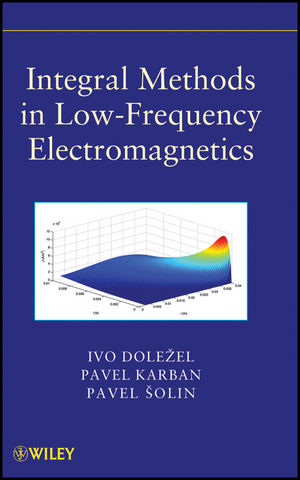Integral Methods in Low-Frequency ElectromagneticsISBN: 978-0-470-19550-5
Hardcover
416 pages
July 2009
 |
||||||
List of Tables.
Preface.
Acknowledgments.
1 Electromagnetic Field and their Basic Characteristics.
1.1 Fundamentals.
1.2 Potentials.
1.3 Mathematical models of electromagnetic fields.
1.4 Energy and forces in electromagnetic fields.
1.5 Power balance in electromagnetic fields.
2 Overview of Solution Methods.
2.1 Continuous models in electromagnetism.
2.2 Methods of solution of the continuous models.
2.3 Classification of the analytical methods.
2.4 Numerical methods and their classification.
2.5 Differential methods.
2.6 Finite element method.
2.7 Integral and integrodifferential methods.
2.8 Important mathematical aspects of numerical methods.
2.9 Numerical schemes for parabolic equations.
3 Solution of Electromagnetic Fields by Integral Expressions.
3.1 Introduction.
3.2 1D integration area.
3.3 2D integration area.
3.4 Forces acting in the system of long massive conductors.
3.5 3D integration area.
4 Integral and Integrodifferential Methods.
4.1 Integral versus differential models.
4.2 Theoretical foundations.
4.3 Static and harmonic problems in one dimension.
4.4 Static and harmonic problems in two dimensions.
4.5 Static problems in three dimensions.
4.6 Time-dependent eddy current problems in one dimension and two dimensions.
4.7 Static and 2D eddy current problems with motion.
5 Indirect Solution of Electromagnetic Fields by the Boundary Element Method.
5.1 Introduction.
5.2 BEM-based solution of differential equations.
5.3 Problems with 1D integration area.
6 Integral Equations in Solution of Selected Coupled Problems.
6.1 Continual induction heating of nonferrous cylindrical bodies.
6.2 Induction heating of a long nonmagnetic cylindrical billet rotating in uniform magnetic field.
6.3 Pulsed Induction Accelerator.
7 Numerical Methods for Integral Equations.
7.1 Introduction.
7.2 Collocation methods.
7.3 Galerkin methods.
7.4 Numerical example.
Appendix A: Basic Mathematical Tools.
A.1 Vectors, matrices, systems of linear equations.
A.2 Vector analysis.
Appendix B: Special Functions.
B.1 Bessel functions.
B.2 Elliptic integrals.
B.3 Special polynomials.
Appendix C: Integration Techniques.
C.1 Analytical calculations of some integrals over typical elements.
C.2 Techniques of numerical integration.
References.
Topic Index.



